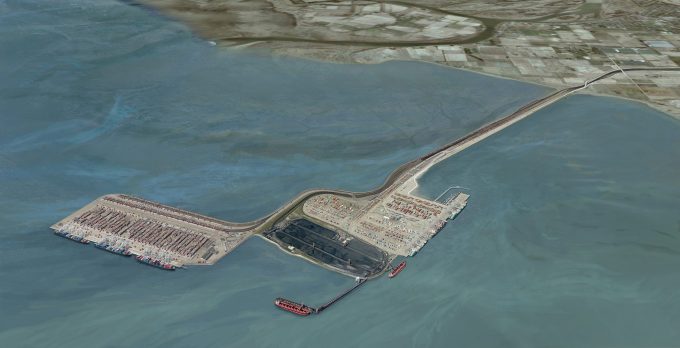ILWU dockworkers agree deal to end Canadian port dispute
It appears the dispute at Canada’s west coast ports is all over. CNBC’s Lori Ann ...
GM: RAISING THE ROOF GGM: IN FULL THROTTLE GZIM: MAERSK BOOST KNIN: READ-ACROSSMAERSK: NOT ENOUGHMAERSK: GUIDANCE UPGRADEZIM: ROLLERCOASTERCAT: HEAVY DUTYMAERSK: CATCHING UP PG: DESTOCKING PATTERNSPG: HEALTH CHECKWTC: THE FALLGXO: DEFENSIVE FWRD: RALLYING ON TAKEOVER TALKODFL: STEADY YIELDVW: NEW MODEL NEEDEDWTC: TAKING PROFIT
GM: RAISING THE ROOF GGM: IN FULL THROTTLE GZIM: MAERSK BOOST KNIN: READ-ACROSSMAERSK: NOT ENOUGHMAERSK: GUIDANCE UPGRADEZIM: ROLLERCOASTERCAT: HEAVY DUTYMAERSK: CATCHING UP PG: DESTOCKING PATTERNSPG: HEALTH CHECKWTC: THE FALLGXO: DEFENSIVE FWRD: RALLYING ON TAKEOVER TALKODFL: STEADY YIELDVW: NEW MODEL NEEDEDWTC: TAKING PROFIT

Plans for a new container terminal at Canada’s largest ocean gateway have cleared a major hurdle.
The federal government has given the thumbs-up to adding a second container facility adjacent to the port of Vancouver’s Deltaport terminal at Roberts Bank.
While port officials welcomed the decision, which came after a ten-year review process, it was met with misgivings by the local community, environmental groups and labour unions.
“With this approval, we can advance one of Canada’s most important trade infrastructure projects bolster our national supply-chain resilience and deliver generational economic benefits for Canadians and Canadian businesses,” said Robin Silvester, president and CEO of Vancouver Fraser Port Authority (VFPA).
The plan calls for the extension of the artificial peninsula, created in the 1990s to house the Deltaport facility, to accommodate a three-berth 2.4m teu terminal boosting the port’s overall capacity by one-third.
It’s needed, according to VFPA, because the port will hit its capacity ceiling towards the end of the decade.
Ottawa’s approval comes with 370 legally binding conditions, from protection of fish and shorebird habitats to a prohibition of new noise that would affect orcas. Nevertheless, environmental protection groups have expressed worries about potentially severe impacts of the project on wildlife.
The mayor of the municipality of Delta, where the terminal will be built, also voiced concerns. Besides potential ecological damage, he pointed to the impact on traffic, indigenous rights and the need for better policing to combat smuggling at the port.
The International Longshore and Warehouse Union (ILWU) in February sent an open letter to the government expressing concern over the impact of the new terminal on the environment and on jobs. Of particular concern to the union is the question of automation.
Rob Ashton, president of ILWU Canada, was scathing in his response to the green light for the project. He said: “This has been a horrible decision by the federal government. The effect on the environment and workers in this province and country we feel will be catastrophic.
“All the federal government has done is told private industry they do not need to invest, they can wait and the government will do it for them by increasing port tenants’ rents and using Canadian taxpayers money.”
Transport minister Omar Alghabra said all container facilities used automation and that the new terminal would be ‘semi-automated’. According to him, the project will support up to 1,500 direct jobs at the terminal and 15,000 beyond, such as in trucking and warehousing.
In February the port’s Centerm container terminal completed an upgrade to boost its capacity by 66% to 1.5m teu, which involved a near-doubling of rail footage, from 245km to 460km, a revamp of gates and staging areas and automation to reduce truck processing time from 4.5 minutes to 45 seconds.
Like other west coast ports, Vancouver has struggled with congestion, a plight exacerbated by catastrophic wildfires and landslides after torrential rains that severed rail and road connections and paralysed imports at the port. Vessel congestion has, essentially, disappeared, but rail flows are still in the slow lane. The port’s dashboard on 21 April showed extended rail on-dock dwell times at all three container terminals. Average dwell times were 3-5 days at Vanterm, 5-7 days at Deltaport and more than seven days at Centerm.
It will be some time before the new box facility will take some load off the others. According to the port authority, it could take six years to build.
Comment on this article